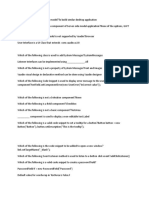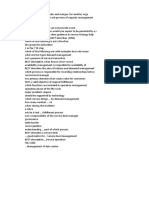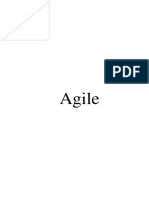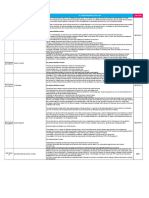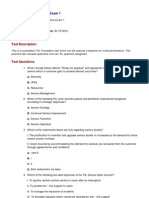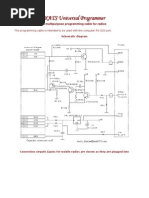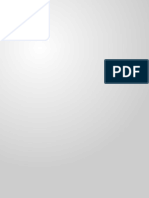Set 2
Set 2
Uploaded by
Anubhav AnkitCopyright:
Available Formats
Set 2
Set 2
Uploaded by
Anubhav AnkitCopyright
Available Formats
Share this document
Did you find this document useful?
Is this content inappropriate?
Copyright:
Available Formats
Set 2
Set 2
Uploaded by
Anubhav AnkitCopyright:
Available Formats
ITIL sample questions, answers are highlighted 1.
One of the five major aspects of Service Design the design of service solutions. Which of the following does this include? A. Only capabilities needed and agreed B. Only resources and capabilities agreed C. Only requirements needed and agreed D. Requirements, resources and capabilities needed and agreed 2. Which of the following are valid examples of business value measures? Customer retention Time to market Service Architecture Market share.
A. 1 and 2 only B. 2 and 4 only C. All of the above D. 1, 2 and 4 only 3. Which of the following might be used to define how a future Problem or Incident could be managed? Incident Model Known Error Record A. 1 only B. 2 only C. Both of the above D. Neither of the above 4. Which of the following is NOT a purpose of Service Transition?
A. To ensure that a service can be managed, operated and supported. B. To provide training and certification in project management C. To provide quality knowledge of Change, Release and Deployment Management. D. To plan and manage the capacity and resource requirements to manage a Release. 5. Which of the following statements BEST describes the aims of Release and Deployment Management? A. To build, test and deliver the capability to provide the services specified by Service Design and that will Accomplish the stakeholders requirements and deliver the intended objectives. B. To ensure that each Release package specified by Service Design consists of a set of related assets and Service components those are compatible with each other. C. To ensure that all Release and Deployment packages can be tracked, installed tested, verified and/or uninstalled or backed out if appropriate.
D. To record and manage deviations, risks and issues related to the new or changed service 6. Which of the following provides resources t resolve operational and support issues during Release and Deployment? A. Early Life Support. B. Service Test Manager C. Evaluation D. Releasing Packaging and Build Manager 7. An IT department is under pressure to cut costs. As a result, the quality of services has started to suffer what imbalance does this represent? A. Extreme focus on cost. B. Extreme focus on quality C. Excessively proactive D. Excessively reactive 8. Which of the following functions would be responsible for management of a data centre? A. Technical Management B. Service Desk C. IT Operations Control D. Facilities Management 9. Availability Management is responsible for availability the of:
A. Services and Components B. Services and Business Processes. C. Components and Business Processes. D. Services, Components and Business Processes 10. Which of the following is a good metric for measuring the effectiveness of Service Level Management? A. Customer satisfaction core B. Average number of daily Incidents managed by each service agent C. Number of services in the Service Portfolio. D. Number of services deployed within agreed times. 11. Which of the following is a valid role in the RACI Authority Matrix?
A. Configuration B. Consulted C. Complex D. Controlled
12.
What is the BEST description of the purpose of Service Operation?
A. To decide how IT will manage with suppliers during the Service Management Lifecycle B. To proactively prevent all outages to IT Services C. To design and build processes that will meet business needs D. To deliver and manage IT services at agreed levels to business users and customers. 13. Which of the following questions does guidance in Service Strategy help answer? What services should we offer and to whom? How do we differentiate ourselves from competing alternatives? How do we truly create value for our customers? A. 1 only B. 2 only C. 3 only D. All of the above 14. Which of the following sentences BEST describes a Standard Change?
A. A Change to the service providers established policies and guidelines B. A Change that correctly follows the required Change process. C. A pre-authorized Change that has an accepted and established procedure D. A Change that is made as the result of an audit 15. What are the types of activity within Demand management?
A. Activity based, Access Management B. Activity based, Business activity patterns and user profiles C. Analytical based Business activity patterns and user profiles. D. Analytical based, shaping user behavior. 16. Which of the following is NOT an aim of the Change Management process? A. Overall business risk is optimized B. Standardized methods and procedures are used for efficient and prompt handling of all Changes C. All changes to Service Assets and Configuration items (CIs) are recorded in the Configuration Management D. System (CMS) E. All budgets and expenditures are accounted for 17. Implementation of ITIL Service Management requires preparing and planning the effective and efficient use of: A. People, Process, Partners, Suppliers B. People, Process, Products, Technology
C. D.
People, Process, Products, Partners People, Product, Technology, Partners
18. Which of the following models would be most useful in helping to define an organizational structure? A. RACI Model B. Service Model C. Continual Service Improvement (CSI) Model D. Plan, Do, Check, Act (PDCA) Model 19. Order the following Continual Service Improvement (CSI) implementation steps into the correct Sequence in alignment with the Plan, Do, Check, Act (PDCA) model. Allocate roles and responsibilities to work on CSI initiatives Measure and review that the CSI plan is executed and its objectives are being achieved Identify the scope, objectives and requirements for CSI Implement CSI enhancement. A. 3-1-2-4 B. 3-4-2-1 C. 1-3-2-4 D. 2-3-4-1 20. Which activities are carried out in the: Where do we want to be?step of the Continual Service Improvement (CSI) Model? A. Implementing service and process improvements. B. Aligning the business and IT strategies C. Creating a baseline D. Defining measurable targets. 21. Which of the following should be supported by technology? Verification of Configuration Management System (CMS) data Control of user desk-tops Creation and use of diagnostic scripts Visibility of overall IT Service performance A. 2, 3 and 4 only B. 1, 2 and 3 only C. 1, 3 and 4 only D. All of the above 22. Understanding customer usage of services and how this varies over time is part of which process? A. Service Portfolio Management B. Service Level Management
C. Component Capacity Management D. Demand Management 23. Which of the following is step 1 in the 7 step Improvement Process?
A. Prepare for action B. Define what you should measure C. Where are we now? D. Identify gaps in Service Level Agreement (SLA) Achievement 24. Which of the following are benefits that implementing Service Transition could provide to the business? Ability to adapt quickly to new requirements. Reduced cost to design new services Improved success in implementing changes
A. 1 and 2 only B. 2 and 3 only C. 1 and 3 only D. All the above 25. The BEST Processes to automate are those that are:
A. Carried out by Service Operations B. Carried out by lots of people C. Critical to the success of the business mission D. Simple and well understood 26. Which of the following is the CORRECT description of the Seven Rs of Change Management? A. A set of questions that should be asked to help understand the impact of Changes. B. A seven step process for releasing Changes into production C. A set of questions that should be asked when reviewing the success of a recent change D. A Definition of the roles and responsibilities required for Change Management 27. Which stages of the Service Lifecycle does the 7 step Improvement Process apply to? A. Service Operation B. Service Transition and Service Operation C. Service Design ,Service Transition and service Operation D. Service Strategy, Service Design, Service Transition, Service Operation and Continual Service Improvement 28. Governance is concerned with:
A. Measuring and improving efficiency and effectiveness of processes B. Ensuring that defined strategy is actually followed C. Reducing the total cost of providing services D. Ensuring that agreed Service Level Requirements are met 29. Which of the following is NOT a valid objective of Request Fulfillment?
A. To provide information to users about what services are available and how to request them B. To update the Service Catalogue with services that may be requested through the Service Desk C. To provide a channel for users to request and receive standard services D. To source and deliver the components of standard services that has been requested 30. Who owns the specific costs and risks associated with providing a service?
A. The Service Provider B. The Service Level Manager C. The Customer D. Resources 31. The MAIN objective of Service Level Management is:
A. To carry out the Service Operations activities needed to support the current IT services B. To ensure that sufficient capacity is provided to deliver the agreed performance of services. C. To create and populate a Service Catalogue D. To ensure that an agreed level of IT service is provided for all current IT services 32. Which of the following is NOT the responsibility of Service Catalogue Manager? A. Ensuring that information in the Service Catalogue is accurate B. Ensuring that information within the Service Pipeline is accurate C. Ensuring that information in the Service Catalogue is consistent with information in the Service Portfolio D. Ensuring that all operational services are recorded in Service Catalogue 33. Which Functions are included in IT Operational Management?
A. Network Management and Application Management B. Technical Management and Application Management C. IT Operations Control and Facilities Management D. Facilities Management and Technical Management 34. Which of the following are activities to be carried out by Supplier Management? Management and review of Organizational Level Agreements (OLAs)
Evaluation and selection of suppliers Ongoing management of suppliers
A. 1 and 2 only B. 1 and 3 only C. 2 and 3 only D. All of the above 35. Which of the following is NOT the responsibility of Service Design Manager?
A. Design and maintain all necessary Service Transition packages B. Produce quality, secure and resilient designs for new or improve services, technology architecture , processes or measurement systems that meet all the agreed current and future IT requirements of the organization. C. Take the overall Service Strategies and ensure they are reflected in the Service Design process and the service designs that are produced D. Measuring the effectiveness and efficiency of Service Design and the supporting processes. 36. Which of the following delivery strategies is described as, Formal arrangements between two or more Organizations to work together to design, develop transition, maintain, operate and /or support IT services A. Outsourcing B. Application Service Provision C. Multi-Sourcing D. Knowledge Process Outsourcing 37. Which of the following is the BEST definition of the term Service Management? A. A Set of specialized organizational capabilities for providing value to customers in the form of services B. A group of interacting, interrelated, or independent components that form a unified whole, operating together for a common purpose. C. The management of functions within an organization to perform certain activities D. Units of organizations with roles to perform certain activities. 38. A. B. C. D. 39. A risk is: Something that wont happen Something that will happen Something that has happened Something that might happen Which of these activities would you expect to be performed by a Service Desk?
Logging details of Incidents and service requests Providing first-line investigation and diagnosis. Restoring service Diagnosing the root-cause of problems
A. All of the above B. 1, 2 and 3 only C. 1, 2 and 4 only D. 2, 3 and 4 only 40. The group that authorizes Changes that must be installed faster than the normal process is called the: A. Technical Management B. Emergency Change Advisory Board (ECAB) C. Urgent Change Board (UCB) D. Urgent Change Authority (UCA)
You might also like
- Milestone - Coding - Python - CuDocument3 pagesMilestone - Coding - Python - Cusmd.raihan001No ratings yet
- Srinyantu Chatterjee ReportDocument1 pageSrinyantu Chatterjee ReportSrinyantu Chatterjee0% (1)
- Performance TestingDocument18 pagesPerformance TestingTeakadai Productions100% (1)
- QuizDocument1 pageQuizsivaguitarNo ratings yet
- 17818Document2 pages17818Viswa MNo ratings yet
- Mandatory TrjdhjaainingDocument3 pagesMandatory TrjdhjaainingKantharaj JV50% (2)
- QuizDocument33 pagesQuizRahul S.KumarNo ratings yet
- Vaadin UnpluggedDocument3 pagesVaadin UnpluggedAyush GargNo ratings yet
- MB1700 Manual de PartesDocument32 pagesMB1700 Manual de Parteserick100% (1)
- Mindell: Automation's Finest Hour. Bell Labs and Automatic Control in wwIIDocument8 pagesMindell: Automation's Finest Hour. Bell Labs and Automatic Control in wwIIwatevaid100% (1)
- Implementation of Uart On An FpgaDocument31 pagesImplementation of Uart On An FpgaNishanth Krishnappa100% (1)
- Itil v3 DumpsDocument39 pagesItil v3 DumpsRahul GhadseNo ratings yet
- ITIL Practise Tests ReviewDocument43 pagesITIL Practise Tests Reviewvijeshoct1984100% (3)
- Process Question BankDocument23 pagesProcess Question BankSteven skylerNo ratings yet
- The Goal For Service Level Management Is To Maintain and Improve The IT Service Quality ThroughDocument10 pagesThe Goal For Service Level Management Is To Maintain and Improve The IT Service Quality Throughrajasudha90100% (1)
- Itil Foundation Set 1Document8 pagesItil Foundation Set 1midomathNo ratings yet
- APIGEE - API Services - QuizDocument5 pagesAPIGEE - API Services - Quizmaribel torresNo ratings yet
- Documents 0d8e3TCS CBODocument3 pagesDocuments 0d8e3TCS CBOShubhangi RaiNo ratings yet
- Consent Form-Digital Proctored Assessments-Wings 1 - September 2021Document1 pageConsent Form-Digital Proctored Assessments-Wings 1 - September 2021Habanero3000No ratings yet
- Which of The Following Is Not Recommended For Change Implementation?Document5 pagesWhich of The Following Is Not Recommended For Change Implementation?Rohit MNo ratings yet
- Which of The Following Is Not Recommended For Change Implementation?Document5 pagesWhich of The Following Is Not Recommended For Change Implementation?Rohit MNo ratings yet
- SQL Queries: 1 / 1 PointDocument4 pagesSQL Queries: 1 / 1 PointArchana shuklaNo ratings yet
- Designed G&T: Which Program Is To Build Program Managers?Document155 pagesDesigned G&T: Which Program Is To Build Program Managers?Namo Narayan NayakNo ratings yet
- Agile E1 CBO 60566 PDFDocument1 pageAgile E1 CBO 60566 PDFarunrdhakrishnantpNo ratings yet
- AGILIDADDocument5 pagesAGILIDADJorge Luis Conde Carbajal100% (1)
- 17818Document2 pages17818Viswa MNo ratings yet
- Session 5: Mechanics Post-Session HomeworkDocument9 pagesSession 5: Mechanics Post-Session Homeworkalexandra owNo ratings yet
- SSIS Questions - HighlightedDocument20 pagesSSIS Questions - HighlightedSaiduluNo ratings yet
- Itilv3 Sample QuestionDocument49 pagesItilv3 Sample QuestionAndika JanuariantoNo ratings yet
- Prasanjit Dash ReportDocument1 pagePrasanjit Dash Reportprasanjit dashNo ratings yet
- 840 403Document3 pages840 403DioYanuarNo ratings yet
- ITIL - Session 03-04 - Service StrategyDocument54 pagesITIL - Session 03-04 - Service StrategyAhmad Abdul HaqNo ratings yet
- CM Story TemplateDocument2 pagesCM Story TemplateRajshekhar Srinivasan100% (1)
- Phone Directory E2 Stage 1Document3 pagesPhone Directory E2 Stage 1atul kumarNo ratings yet
- Digital - PythonDocument5 pagesDigital - PythonRaviNo ratings yet
- ArticulationDocument26 pagesArticulationharshit kuchhalNo ratings yet
- Ms 201Document1 pageMs 201Gaurav SrivastvaNo ratings yet
- Wings1 Process NotesDocument73 pagesWings1 Process NotesAbitha K SNo ratings yet
- Essentials (55104)Document4 pagesEssentials (55104)dibyalovep2015No ratings yet
- 72417Document13 pages72417Samiul IslamNo ratings yet
- Implied Status LTR - RavishankarDocument2 pagesImplied Status LTR - RavishankarRaviShankar SubrahmanyamNo ratings yet
- Self Assessment Questions & AnswersDocument6 pagesSelf Assessment Questions & Answerssuman8sam0% (1)
- List of JDsDocument8 pagesList of JDsPriyanshu Agrawal100% (1)
- Course Name: Process: Agile For Practitioners Assessment - Delivery Course Name: 56978Document24 pagesCourse Name: Process: Agile For Practitioners Assessment - Delivery Course Name: 56978Arkya ManniNo ratings yet
- Mgmt630 Solved QuizDocument40 pagesMgmt630 Solved Quizaepatil74100% (1)
- Performance Categories: Pprreeeettii Vviirrcchhaanndd Cchhhheeddaa ( (11221122009922@ @Ttccss..Ccoom M) )Document21 pagesPerformance Categories: Pprreeeettii Vviirrcchhaanndd Cchhhheeddaa ( (11221122009922@ @Ttccss..Ccoom M) )MILAN KUMAR MOTTANo ratings yet
- HTML5 HandsOnDocument3 pagesHTML5 HandsOnAnkit MathurNo ratings yet
- Agile Ques1Document2 pagesAgile Ques1dreamlet20% (10)
- Katalon Studio AssessmentDocument19 pagesKatalon Studio AssessmentJitendra BattiseNo ratings yet
- Course Name: Process: Agile For Practitioners Assessment - Delivery Course Name: 56978Document24 pagesCourse Name: Process: Agile For Practitioners Assessment - Delivery Course Name: 56978Brajakishore DasNo ratings yet
- JIRA RespuestasDocument4 pagesJIRA RespuestasDavid OlánNo ratings yet
- AnsDocument3 pagesAnssaichait100% (2)
- PDF Itil v3 Mock Exam Day 21 CompressDocument6 pagesPDF Itil v3 Mock Exam Day 21 Compressudaya ramamurthyNo ratings yet
- ISecurity Quiz - Generic Question and Answer - Technicalblog - inDocument5 pagesISecurity Quiz - Generic Question and Answer - Technicalblog - inManish RajNo ratings yet
- EDCI 655: Assessment of Learning and The Learner Course SyllabusDocument6 pagesEDCI 655: Assessment of Learning and The Learner Course Syllabusgrace seldaNo ratings yet
- 000-647 RPTDocument43 pages000-647 RPTdineshNo ratings yet
- Agile For Practitioners AssessmentDocument4 pagesAgile For Practitioners AssessmentEr. ShivamNo ratings yet
- 7 ITIL V3 Foundation Sample Exam 3Document15 pages7 ITIL V3 Foundation Sample Exam 3Savitha MohanNo ratings yet
- ITIL V3 Sample Paper 3Document11 pagesITIL V3 Sample Paper 3bala2610No ratings yet
- ITILDocument16 pagesITILMohan AgarwalNo ratings yet
- Sample Paper 3: Data Classification: PublicDocument7 pagesSample Paper 3: Data Classification: PublicJatinder Pal SinghNo ratings yet
- Questoes ItilV3Document31 pagesQuestoes ItilV3Moacir JacominNo ratings yet
- ITIL® Exam 01Document10 pagesITIL® Exam 01gr8personalityNo ratings yet
- Rear Bumper Reinforcement Removal/Installation: 2008 Mazda CX-9 Grand Touring 2008 Mazda CX-9 Grand TouringDocument17 pagesRear Bumper Reinforcement Removal/Installation: 2008 Mazda CX-9 Grand Touring 2008 Mazda CX-9 Grand TouringЯрослав ПіхманецьNo ratings yet
- E1.ENO (OL) Question CMA January-2023 Exam.Document5 pagesE1.ENO (OL) Question CMA January-2023 Exam.sama tahsinNo ratings yet
- Tips To Help Observers Match Into A Residency ProgramDocument1 pageTips To Help Observers Match Into A Residency Programsavas akshayNo ratings yet
- IEC 62561-4-2023Document50 pagesIEC 62561-4-2023acalero1984No ratings yet
- Unit 43 Assignment 1 FulldocxDocument26 pagesUnit 43 Assignment 1 FulldocxNguyễn Văn MạnhNo ratings yet
- Defectometer 2.837: Eddy Current Test Instrument DEFECTOMETER 2.837Document11 pagesDefectometer 2.837: Eddy Current Test Instrument DEFECTOMETER 2.837Ronny AndalasNo ratings yet
- NITT - MBA T&P Resume TemplateDocument1 pageNITT - MBA T&P Resume Templateparthiban44018933No ratings yet
- KATS Universal ProgrammerDocument6 pagesKATS Universal ProgrammerdorudNo ratings yet
- Logic Gates - Class 12 Physics Investigatory Project Report Free PDF DownloadDocument21 pagesLogic Gates - Class 12 Physics Investigatory Project Report Free PDF DownloadYug SharmaNo ratings yet
- F6FORBALDocument64 pagesF6FORBALjadecarvy18No ratings yet
- Creativity Source of New Idea Ideas Into OpportunitiesDocument19 pagesCreativity Source of New Idea Ideas Into OpportunitiesOnkar BhatkandeNo ratings yet
- English For Academic and Professional Purposes MODULE 3 - Approaches in Literary CriticismDocument7 pagesEnglish For Academic and Professional Purposes MODULE 3 - Approaches in Literary CriticismGrazel Anne TibaydeNo ratings yet
- 4909WP - DM82-DM124 PUB 07-02 Rev 04-04Document45 pages4909WP - DM82-DM124 PUB 07-02 Rev 04-04Ivan PANo ratings yet
- Control of Management Reviews Procedure Sample PDFDocument4 pagesControl of Management Reviews Procedure Sample PDFMadan R HonnalagereNo ratings yet
- Applications of Trigo Previous Year QuestionsDocument2 pagesApplications of Trigo Previous Year QuestionsRITU KUMARNo ratings yet
- Feedback and Control Systems Laboratory: ECE131L/B5/4Q1920Document8 pagesFeedback and Control Systems Laboratory: ECE131L/B5/4Q1920Benj MendozaNo ratings yet
- Features General Description: Ht78Xx Series 500ma Tinypower LdoDocument9 pagesFeatures General Description: Ht78Xx Series 500ma Tinypower LdomessyaxNo ratings yet
- Branches of DIASSDocument3 pagesBranches of DIASSIssaVillanueva100% (2)
- Strategic Marketing - Lecture 5 Market Vision, Structure and AnalysisDocument31 pagesStrategic Marketing - Lecture 5 Market Vision, Structure and AnalysisKanwal AsgharNo ratings yet
- GMRC Recruitment 2021 NotificationDocument5 pagesGMRC Recruitment 2021 NotificationHiren ParmarNo ratings yet
- HVAC Calculation 380kV GIS Bldg. Rev-02Document170 pagesHVAC Calculation 380kV GIS Bldg. Rev-02Mohammed Elmak100% (1)
- Dolanto Pharma & SS Equipment BrochureDocument26 pagesDolanto Pharma & SS Equipment BrochureAKKAD PHARMANo ratings yet
- LESSON 5 - The Science in Arts and The Art in ScienceDocument13 pagesLESSON 5 - The Science in Arts and The Art in ScienceEvane QuimadaNo ratings yet
- Formulation, Implementation, and Control: Eleventh EditionDocument6 pagesFormulation, Implementation, and Control: Eleventh EditionKiko HuitNo ratings yet
- Senior Cost ConsultantDocument1 pageSenior Cost ConsultantSelvaNo ratings yet
- MASTERBATCHDocument3 pagesMASTERBATCHHang TrieuNo ratings yet
- Claval Valves CatalogueDocument256 pagesClaval Valves Catalogueali kamel aliNo ratings yet







